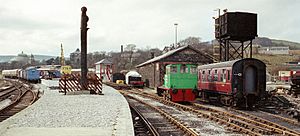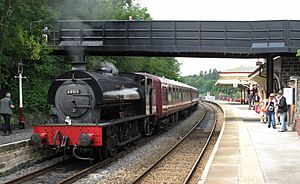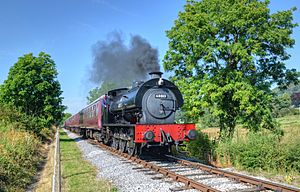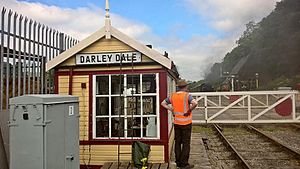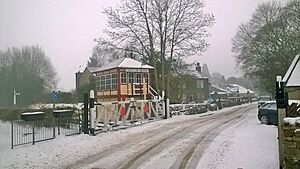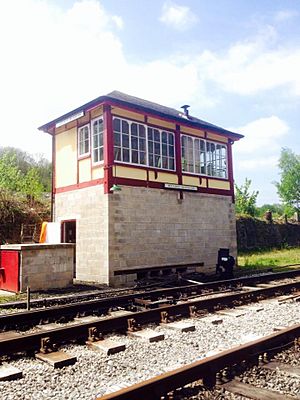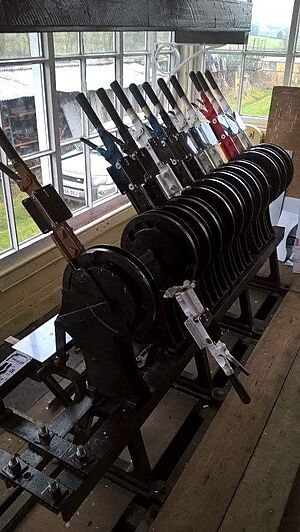Peak Rail facts for kids
Quick facts for kids Peak Rail |
|
|---|---|
 |
|
| Commercial operations | |
| Original gauge | 4 ft 8 1⁄2 in (1,435 mm) standard gauge |
| Preserved operations | |
| Operated by | Peak Rail |
| Stations | 3 |
| Length | 4 miles (6.4 km) |
| Preserved gauge | 4 ft 8 1⁄2 in (1,435 mm) |
| Commercial history | |
| Opened | 1863 |
| Closed | 1968 |
| Preservation history | |
| 1987 | Acquires Darley Dale and track relay work begins |
| 1991 | Light Railway Order granted |
| 1992 | Re-opened |
| 1997 | Extended to Rowsley South |
| 2 July 2011 |
Extended to Matlock |
| Headquarters | Matlock |
Peak Rail is a special railway in Derbyshire, England. It runs old steam and diesel trains for people visiting the beautiful Peak District and Derbyshire Dales.
The railway line is over three and a half miles (5.6 km) long. As of 2016, trains run from Matlock station to Rowsley South. Along the way, they pass by the old Matlock Riverside and Darley Dale stations.
Peak Rail hopes to make its line even longer in the future. They want to reach Bakewell, which would make the line about 4.25 miles (6.84 km) long. After Bakewell, the old railway path is now a walking and cycling trail called the Monsal Trail.
Contents
History of Peak Rail
Early Efforts to Save the Railway
In 1975, a group called the Peak Railway Preservation Society started. They opened a place called the Buxton Steam Centre. Here, they could fix up old trains and had a short track for them to run on.
They wanted to make the track longer, but it didn't happen. They even bought a bridge to connect to another railway line, but it was never used. The whole area was later sold to a company that built a factory there. Peak Rail then moved to Darley Dale.
Moving to Darley Dale
In the 1980s, Peak Rail moved its main base to Darley Dale. By 1991, they had reopened a section of the line. This part ran between Matlock Riverside and Darley Dale.
In 1997, the line got even longer. It was extended to Rowsley South. A new station was built there, with a big car park. This station is used for special events like charity gatherings and car shows. Being close to the Peak District, the railway is near other fun places like Bakewell, Haddon Hall, and Chatsworth House.
Reaching Matlock Station
Later, the railway was able to connect to the main Matlock station. This station is also used by other trains that are part of the national railway network.
After some talks, Peak Rail was allowed to use the Matlock platform for 50 years. The tracks were reconnected, and the extension to Matlock officially opened on July 2, 2011.
Fun Events at Peak Rail
Peak Rail doesn't just run regular trains. They also have many exciting special events!
- Santa Specials: Around Christmas, families can ride special trains to see Santa.
- Warring Forties: This event brings history to life with World War Two battle re-enactments. You can see old military vehicles and people dressed in period costumes.
- Diesel Galas: These days celebrate diesel locomotives, with many different types of diesel engines running.
- Music Festivals: Sometimes, the railway hosts local music events.
You can also enjoy a meal on "The Palatine" restaurant train on certain days. At Darley Dale, there is a small museum about the railway's local history.
Groups at the Railway
Many groups that love railways work at Peak Rail. They help to keep the railway running and restore old trains.
- The Heritage Shunters Trust has a large collection of old shunting locomotives. Shunters are small engines used to move carriages around.
- The LMS Carriage Association works to restore old train carriages.
- The Renown Repulse Locomotive Group is fixing up two special Class 50 diesel locomotives.
- Other people also keep and restore their own old trains and wagons at the railway.
The Trains at Peak Rail
The trains that run on a railway are called "motive power." Peak Rail has many different types of engines, both steam and diesel.
Steam Locomotives
Peak Rail has several steam locomotives. Some are ready to run, while others are being fixed up.
- Operational: Currently, there are no steam locomotives running regularly.
- Being Fixed Up:
* GWR 4575 Class No. 4588, built in 1927. This engine is being repaired at another workshop before coming to Peak Rail. * GWR 4575 Class No. 5553, built in 1928. This one is owned by Pete Waterman and is also being fixed up. * Hunslet Austerity 0-6-0ST No. 7136, built in 1944. This engine is also known as "Royal Pioneer."
Diesel Locomotives
Peak Rail has many diesel locomotives. These are engines that run on diesel fuel.
- Operational:
* Several small shunting engines, like Class 01 no. D2953 and Class 03 no. 03099. Many of these are owned by the Heritage Shunters Trust. * Larger engines like Class 31 no. 31270 and Class 44 no. D8 "Penyghent."
- Being Fixed Up:
* Some diesel engines are currently being restored, such as Class 14 no. D9525 and Class 50 no. 50030 Repulse.
Diesel Multiple Units
These are trains that have their own engines in each carriage, so they don't need a separate locomotive.
- Being Fixed Up:
* Class 117 nos. 51354 and 51396 are being restored.
Railway Signals
Signals are important for keeping trains safe. They tell train drivers when to stop or go. Peak Rail has four signal boxes along its line. A signal box is a building where a person controls the signals and points (the parts of the track that let trains switch lines).
- Matlock Riverside: This signal box used to be at a different location. It helps control trains entering and leaving the loop at Darley Dale.
- Darley Dale Crossing: This box controls a level crossing where the railway crosses a road.
- Darley Dale Station: This signal box helps trains pass each other on the "passing loop" at Darley Dale.
- Church Lane Crossing: This box also controls a level crossing. The signals here are old ones from 1927.
- Rowsley South: This signal box was moved to Rowsley in 2014 and is being restored. It will help control trains in the engine sheds and yard.
Running Two Trains
In 2007, Peak Rail made improvements that allow two trains to run on the line at the same time. This was made possible by fixing up and extending the passing loop at Darley Dale. This means more trains can run, making visits even more exciting!
Darley Dale Footbridge
In 2009, Peak Rail bought an old footbridge that used to be at Darley Dale. They plan to fix it up and put it back in its original spot. This will allow people to cross the tracks safely and enjoy the view.


